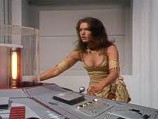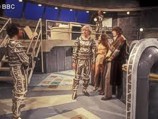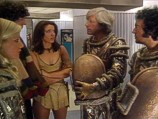 |
|
Leela in the TARDIS
|
|
 At the edge of expanding universe The TARDIS arrives on board a Minyan spacecraft, the R1C, commanded by a man named Jackson. Jackson and his crew are on a long quest to recover the Minyan race banks from a ship called the P7E which left Minyos aeons ago. At the edge of expanding universe The TARDIS arrives on board a Minyan spacecraft, the R1C, commanded by a man named Jackson. Jackson and his crew are on a long quest to recover the Minyan race banks from a ship called the P7E which left Minyos aeons ago.
 The Minyans are suspicious of The Doctor as they know his race of old. In the history of the Time Lords, their involvement with the Minyans is regarded as a disaster. The Minyans looked on them as gods but, having learnt much from their science, later expelled the Time Lords who thereafter adopted a policy of non-intervention. The Minyans resented the Time Lords for their dominion over Minyos. Subsequently, the Minyans engaged in a civil war, using the advanced weapons the Time Lords gave them. The Minyans are suspicious of The Doctor as they know his race of old. In the history of the Time Lords, their involvement with the Minyans is regarded as a disaster. The Minyans looked on them as gods but, having learnt much from their science, later expelled the Time Lords who thereafter adopted a policy of non-intervention. The Minyans resented the Time Lords for their dominion over Minyos. Subsequently, the Minyans engaged in a civil war, using the advanced weapons the Time Lords gave them.
 In the final conflict, the Minyans destroyed their world. Two ships left Minyos before the final conflict, one carrying the race bank of the Minyans, the other intended to find the race bank and bring the Minyans to a new homeworld - Minyos II. The Minyan civilisation retained some Time Lord gifts, not least cellular rejuvenation and the use of pacifier guns to alter the mental state of the aggressor. In the final conflict, the Minyans destroyed their world. Two ships left Minyos before the final conflict, one carrying the race bank of the Minyans, the other intended to find the race bank and bring the Minyans to a new homeworld - Minyos II. The Minyan civilisation retained some Time Lord gifts, not least cellular rejuvenation and the use of pacifier guns to alter the mental state of the aggressor.
 | | The Doctor and Herrick |
|
 On visiting visit the bridge of the R1C, The Doctor, Leela and K9 find a crew of four, Jackson, Herrick, Orfe and Tala, who are on a quest that has taken many millennia - The Minyans having rejuvenated many times so as to continue with their aim to find the missing spaceship, the P7E, which disappeared en-route to Minyos II while carrying the genetic race banks of their entire species. On visiting visit the bridge of the R1C, The Doctor, Leela and K9 find a crew of four, Jackson, Herrick, Orfe and Tala, who are on a quest that has taken many millennia - The Minyans having rejuvenated many times so as to continue with their aim to find the missing spaceship, the P7E, which disappeared en-route to Minyos II while carrying the genetic race banks of their entire species.
 They have, however, finally traced the P7E’s signal and head into a nebula to locate the missing spaceship. In the process the R1C is nearly destroyed, and is almost transformed into a planetoid as small space rocks become attracted to it and so nearly crush the hull. The Doctor helps the Minyans to free the R1C. However, it then crashes into another newly formed planet at the heart of which they discover is the P7E. They have, however, finally traced the P7E’s signal and head into a nebula to locate the missing spaceship. In the process the R1C is nearly destroyed, and is almost transformed into a planetoid as small space rocks become attracted to it and so nearly crush the hull. The Doctor helps the Minyans to free the R1C. However, it then crashes into another newly formed planet at the heart of which they discover is the P7E.
 | | Meeting the Minyans |
|
 Inside the new planet the time travellers and the Minyans discover a maze of tunnels and passages. They also discover that civilisation on the P7E planetoid has taken a curious turn. Most of the population live as slaves digging rock for fuel and sustenance, but they are culled and killed in rock collapses called Skyfalls. This situation is overseen by guards who are in turn responsible to two robots called Seers. Inside the new planet the time travellers and the Minyans discover a maze of tunnels and passages. They also discover that civilisation on the P7E planetoid has taken a curious turn. Most of the population live as slaves digging rock for fuel and sustenance, but they are culled and killed in rock collapses called Skyfalls. This situation is overseen by guards who are in turn responsible to two robots called Seers.
 In overall control is the Oracle, a powerful super-computer which has shaped this perverse society. The Oracle, is in fact the P7E’s computer. Evidently the P7E became trapped in the planet millennia earlier and the entire basis of the mission was lost over time. The computer was originally programmed to protect the race banks but has gone insane and dominated the Minyan survivors and their descendants. In overall control is the Oracle, a powerful super-computer which has shaped this perverse society. The Oracle, is in fact the P7E’s computer. Evidently the P7E became trapped in the planet millennia earlier and the entire basis of the mission was lost over time. The computer was originally programmed to protect the race banks but has gone insane and dominated the Minyan survivors and their descendants.
 The Doctor and Leela venture into this perverted society and encounter Idas, a young man nearly killed in a Skyfall, learning how the local population is managed and terrorised. The Seers and Oracle exist in a protected Citadel at the heart of the planetoid (the P7E) and The Doctor, Leela and Idas venture there, in the process rescuing Idas’ father Idmon who was due to be sacrificed to the Oracle. Other slaves are freed too, and flee to the R1C where Jackson makes them welcome. The Doctor and Leela venture into this perverted society and encounter Idas, a young man nearly killed in a Skyfall, learning how the local population is managed and terrorised. The Seers and Oracle exist in a protected Citadel at the heart of the planetoid (the P7E) and The Doctor, Leela and Idas venture there, in the process rescuing Idas’ father Idmon who was due to be sacrificed to the Oracle. Other slaves are freed too, and flee to the R1C where Jackson makes them welcome.
 | | Leela with the Minyans |
|
 However, the crucial race banks remain in the control of the Oracle. The Doctor, Leela, and Idas venture to the Citadel again to get the precious cargo. But unknown to them the Seers have managed to capture Herrick and have given him what he thinks are the two race banks to take back to the R1C. Jackson, Orfe and Tala are overjoyed, little realising that Herrick has actually brought primed fission bombs back to the R1C. However, the crucial race banks remain in the control of the Oracle. The Doctor, Leela, and Idas venture to the Citadel again to get the precious cargo. But unknown to them the Seers have managed to capture Herrick and have given him what he thinks are the two race banks to take back to the R1C. Jackson, Orfe and Tala are overjoyed, little realising that Herrick has actually brought primed fission bombs back to the R1C.
 The Doctor has meanwhile made it to the core of the Citadel and confronted the Oracle. He succeeds in locating and stealing the real race banks and then heads off with Leela and Idas to get back to the R1C. The guards try but fail to defeat their flight. The Doctor gives the real race banks to Jackson, and then takes the fission bombs out of the spaceship. Idas takes advantage of the situation to round up the other slaves or Trogs and lead them to the safety of the R1C while The Doctor engineers the fission grenades are returned to the Oracle. The Doctor has meanwhile made it to the core of the Citadel and confronted the Oracle. He succeeds in locating and stealing the real race banks and then heads off with Leela and Idas to get back to the R1C. The guards try but fail to defeat their flight. The Doctor gives the real race banks to Jackson, and then takes the fission bombs out of the spaceship. Idas takes advantage of the situation to round up the other slaves or Trogs and lead them to the safety of the R1C while The Doctor engineers the fission grenades are returned to the Oracle.
 With moments to spare, the R1C blasts away, loaded with the slaves and the race banks, and is pushed outward from the planetoid by the explosion of the fission grenades. The TARDIS crew depart, wishing the Minyans well as they journey on to Minyos II, their quest complete. With moments to spare, the R1C blasts away, loaded with the slaves and the race banks, and is pushed outward from the planetoid by the explosion of the fission grenades. The TARDIS crew depart, wishing the Minyans well as they journey on to Minyos II, their quest complete.
|